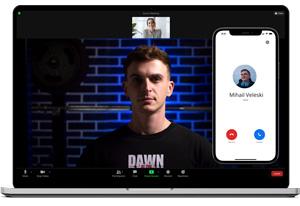If you have pectus excavatum and your job demands you to sit down and look at screens, stand up, and put the computer in an elevated position that allows you to stand while working.
This may be more physically challenging at first. You may feel exhausted after an entire shift, especially if your deformity is severe and causes you to exercise intolerance.
However, you will get used to it. You'll build the strength and endurance to endure a complete shift.
The benefits will be huge, and your pectus posture will stop worsening, improving your sunken chest appearance.
Benefits of Standing Upright
What makes the human creature so powerful on this planet, among other things, is that we stand upright. This position gives us a lot of benefits over other animals.
As we get older, our posture declines into the fetal position we were once in. There's a saying we are becoming babies twice and men only once.
We don't only see older people with a declined posture. Nowadays, even younger people walk around slouched over with poor posture, mainly because we spend most of our life in front of the computer at work or home.
The posture drastically degraded when the workforce changed, especially when men went from labor to computers and sat in offices rather than standing upright in factories.
Sitting
Slouching while sitting is very common in our society. The increase in smartphone and computer usage led us to sit with our shoulders slumped over and forward head posture.
Suppose you want to improve your pectus excavatum without surgery. In that case, you must pay attention and fix the muscular imbalances caused by improper sitting.
Correct Sitting Position
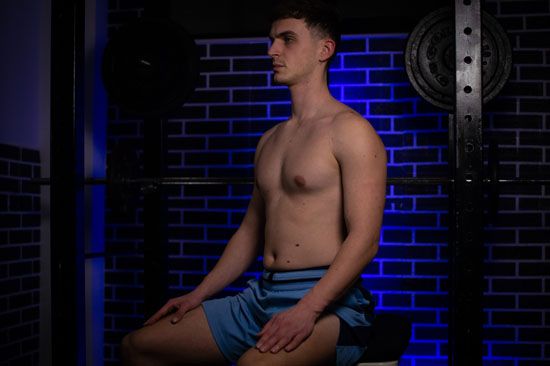
We can tolerate the force better if we sit correctly with a standard S curve. However, we don't sit properly throughout the day. We usually sit in a C curve, which puts a lot of pressure on the discs.
Sit with your back straight and your shoulders back and down. Your glutes need to touch the end of the chair you sit on.
What My Doctor Told Me About Sitting
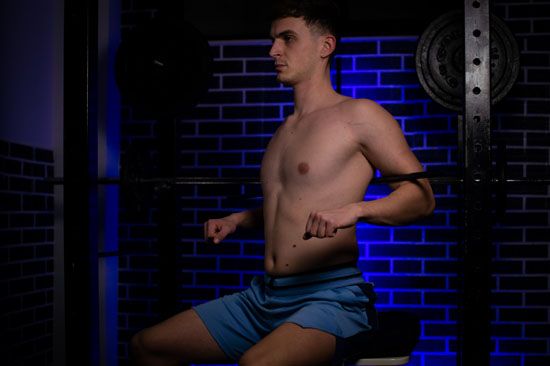
When I was diagnosed with pectus excavatum by my doctor, Blagoja Gjorgjieski (д-р Благоја Ѓорѓиески in Cyrillic) instantly noticed my poor posture.
He explained to me that it was probably caused by improper sitting.
I explained that I was playing video games all day, every day. As funny as it may sound, he told me to put a thin rolling pin behind my back, with my elbows fully drawn back and my shoulders back and down.
After trying it at first, it felt extremely uncomfortable. It forced me into a posture that I had never experienced before.
After taking it off, I instantly felt my posture improved, allowing me to breathe more naturally.
I continued doing this until my posture improved. My body finally got used to this posture while I was sitting, to the point where I didn't need the thin rolling pin to sit correctly on my desk anymore.
Your sitting posture will be better if your feet are closer to your hips and your knees are closer to your chest. I recommend you elevate your feet on a small step stool. That will naturally shorten your anterior chain while sitting, resulting in a better posture.
Morning Exercise
It would be best if you hung from a pull-up bar in the morning to stop this from happening. This is a straightforward and helpful tip. Decompress your spine, and be motivated by realizing how much you'll be sitting during the day.
My doctor Blagoja Gjorgjieski recommended getting a pull-up bar in my home. He advised me to do a lot of pull-ups throughout the day. This helped me improve my posture and decompress my spine because I spent a lot of time playing video games such as World of Warcraft, DOTA, Starcraft, etc.
The goal is to hang for about 60 seconds. To feel this stretch more intensely, try to remain in contact with your feet with the ground. This will allow the pelvis to drop, making the spine decompress.
What Helped Me a Lot
I work in front of my computer for many hours in a sitting position during the day. I now recognize that my body doesn't appreciate it, especially after I have a challenging workout in my home gym.
There are specific things I tend to do nowadays that have helped me improve my ergonomics. The one thing that made the biggest difference was putting my laptop in an elevated position so I didn't have to sit while working long hours.
I haven't yet purchased a standing desk, but I plan to do so. It will help stop the worsening of the poor pectus posture while sitting in an unnatural and improper position, flexed over the computer, or looking down.
The monitor should be placed at a head-level height by setting it on a box so that you will look up at it.
Mix Sitting and Standing
I spend a lot of time writing blog posts and attending online classes. I started enjoying mixing sitting and standing during work time. When my body gets achy when I sit too long, I use my custom stand-up desk and put my laptop on it. Then, after I am tired, I sit again and repeat.
When you sit down, you don't think about your feet. When you stand, the feet are always on your mind. It is essential to wear comfortable slippers or stand on a carpet for more comfort.
Stand Up Every 30 Minutes
If you sit all day, the best thing you can do is get up every 30 minutes and do a few easy mobility exercises for five minutes. Focus mainly on the tight hips, upper back, neck, and ankles. This is one of the most helpful things you can do if you don't like to work on a stand-up desk.
Most of us with pectus excavatum will benefit from the extra mobility and stretching exercises because the deformity causes muscular imbalances, especially in the upper back, neck, and chest.
5 Mobility Exercises to Reverse Damage
It can help you sit in the correct position. However, you're not active when you sit and are still in an unnatural position, no matter how well you sit.
Cross-legged sitting is a static stretch, which might help with the range of motion in the hips. Still, it won't necessarily improve mobility. Stand up and do the following active mobility exercises:
- Leg swings
- 90-90 stretch with your hips on the ground
- The combat stretch
- Handcuffs with rotations
- Wall press
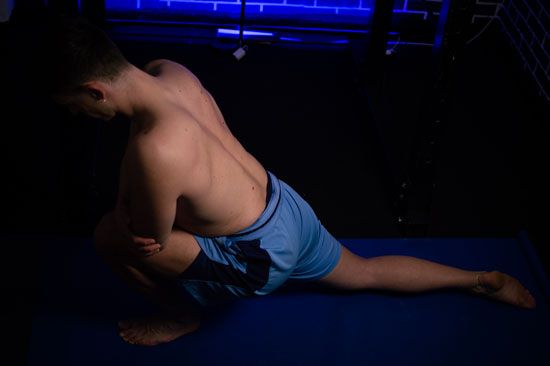







These will improve mobility and poor pectus posture.
Do this for about 5 minutes every 30 minutes. If you work eight hours daily, 40 minutes of mobility work in the day is fantastic.
If you do this five times a week, you'll notice substantial postural improvement, and your lower back and hips will feel much better.
3 Steps - GBS Routine
You can also follow this simple routine created by Jeff Cavaliere from Athlean X.
Set the timer for 30 minutes. Please don't sit for more than 30 minutes at a time. The Pomodoro technique perfectly aligns with this.
- G - Grab
- B - Bridge
- S - Squat
1. Grab

When the 30-minute mark passes by, I want you to stand up and grab your butt cheeks on the top with the heels of your hands. Push your hips forward and stretch your body. It is essential to touch the butt, not the lower back.
This way, we will control the pelvis. The grab exercise will reverse postural damage from sitting. It will get an extension of the hips rather than flexing—knee extension rather than flexion. One can open the chest and shoulder rather than sit with rounded shoulders.
The thoracic extension is increased, as opposed to pectus posture while sitting. These things will get reversed quickly by doing the grab exercise for about 30 seconds.
Then, the second part of this exercise is to do this again before we sit down, but actively, not passively. This time squeeze the glutes and the shoulder blades together as you push forward.
Hold for 30 seconds. Then, go back to sitting, and you'll feel a massive release. Set the timer again for 30 minutes and continue your working session.
2. Bridge

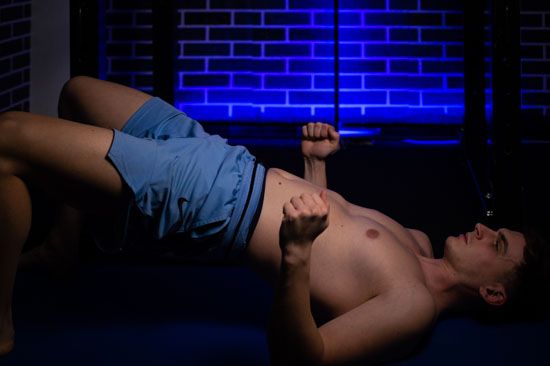
The following exercise is the bridge. This will help you get active contraction of the glutes and have an additional effect on the thoracic spine. Reach with your arms to the opposite side simultaneously, and twist as you extend your hips.
You can do this easily and quickly. Perform five repetitions on each side, and continue working for the next 30 minutes. You will benefit by interrupting the sitting pattern that does all the postural damage.
3. Squat

The next time the timer goes off, we finish it with the squat movement. To get in position:
- Get next to a wall and take a deep squat.
- Hold your back against the wall. You'll feel tight because of sitting a lot.
- Cultivate the ability to get into a deep squat position.
This has an additional benefit for the ankle mobility I mentioned before. Reach the arms up to the wall in a cactus position. The thoracic extension you'll receive helps you correct pectus posture.
The rotator cuffs will be activated too. We get a lot of internal shoulder rotation while we sit, causing trouble. Friction your arms against the wall and extend up, then squeeze the back in the lower position.
Hold the squat for about 30 seconds, and do five-arm raises against the wall.
Repeat
Repeat the whole sequence for as long as you work in a sitting position. After you do the first GBS session, repeat GBS. It should look like this: GBSGBS etc.
Do this throughout the day. Don't worry if you miss some of these during the day. Building consistency by doing these at least a few times in the day would be best. That will reverse the damage already done. It is straightforward and effective.
How I Sit

I like to sit wide-legged with one foot over the knee. I sometimes pressure my knee to increase the stretch, make my hip feel better, and relieve tension.
When my performance starts to suffer in the gym, especially in the hips while I front squat, that is a sign I need to stop sitting for long hours throughout the day. I try to pay attention to my foot positioning.
There are minor modifications that make a huge difference. I want to be more conscious about my sitting and posture. Mobility exercises will unwind you. Try to know that certain things will create tightness and pain. Recognize how you sit and your posture is very positive.
If someone hits in Indian style, the opposite of how most of us are used to sitting is a way to feel comfortable on the hips and lower back. Going back and forth between these leg positions is not a good habit. Sitting cross-legged will not help your lower back.
It temporarily helps because you're stretching the tight hips slightly. This is crutching the root cause of the problem. You probably lack adequate external rotation in the hips, and because of that, this type of setting feels very comfortable.
Do the mobility exercises and work on your core strength.
How to Reverse Damage
If you sleep for 8 hours a night, you're awake for 16 hours. If you're working for 8 hours in an office, driving to many factorsable for one hour, and watching TV after you home from work, you spend almost your whole day sitting.
This is bad for your poor posture and sunken chest deformity, and your overall appearance will worsen.
The previously mentioned study revealed the adverse effects of sitting for 11 hours daily. In reality, we usually spend almost all hours sitting while awake, which can be more than 13 hours a day. This is very concerning, not just for us, the people with pectus excavatum, but for everyone.
We know that sitting too much will cause damage to our body, even leading to lower cross syndrome. This will tighten your hips and weaken your glutes, even causing trouble when standing.
Sitting applies a lot of stress to your back and spine. This creates a lot of muscular problems too.
Associated Problems With Sitting
If we sit too long during the day, we will have
- Poor peripheral circulation and blood flow
- Decreased insulin sensitivity
- 90-95% decrease in lipoprotein lipase
- Premature cell aging
This will make us fat, and the extra weight isn't helpful for our situation. The pot-belly appearance will make our deformity appear much worse than it is.
Studies prove that sitting a couple of hours in the day will make your cells age more quicker.
1 Hour of Exercising Can't Reverse Damage
There's scientific evidence showing that 1 hour of workout is not enough to counteract the damage your body is undergoing by sitting down too much in an improper position.
No matter how much you work out, I recommend adding GBS to counteract the damage caused by excessive sitting.
Add Face Pulls


Adding face pulls at the end of each gym workout session will help you. Add just one set of exercises for 15 repetitions. It will work all the inactive muscles because of sitting and improper posture.
You'll see a fantastic improvement in adding GBD a few times throughout the day to interrupt the sitting pattern. Adding face pulls will be the cherry on the cake for your pectus excavatum posture.
Standing Desks for Pectus Excavatum
Are standing desks good for us, people with pectus excavatum?
A 2015 study revealed that office workers should stand on their feet and work at standing desks for two hours in the day and aim to increase to four hours. This doesn't mean standing for four hours in one go.
The point is to break prolonged seating. Break this by using a standing desk, walking, or doing standing activities. The goal is to stand for 4 hours in total during the day.
2018 Study
A 12-month 2018 study on NHS office workers found that providing these workers with adjustable desks where they can sit or stand reduces the sitting time by about an hour. The body requires standing.
That's how our ancestors spent the majority of their waking hours. Prolonged sitting is an uncomfortable and unnatural position for the human body. The study also revealed better job performance, reduced anxiety, sickness at work, and superb overall quality of life.
These studies prove that standing up at desks while working is beneficial mentally and physically. This is precisely what we need as individuals with a sunken chest deformity whose posture is more prone to worsening.
2012 Study
A 2012 study showed that adults who sat more than 11 hours a day were 40% more probably to die in the next three years. Even though there are a lot of factors that make this stat as frightening as it is, we nowadays sit more than we ever have in our life.
The Bottom Line
We all know that being physically active is good for mental and physical health. However, we still ignore that sitting for prolonged hours over an extended period will worsen our life and physique.
Stopping prolonged sitting by investing in a stand-up desk makes a huge difference. I encourage you to stand while working to reap these excellent benefits and reverse the damage already done. Thank you for reading!
9 Sources
- Jung SI, Lee NK, Kang KW, Kim K, Lee DY. The effect of smartphone usage time
on posture and respiratory function. J Phys Ther Sci. 2016 Jan;28(1):186–9. - Sitting-and-disc-pressure.pdf [Internet]. [cited 2022 Dec 2]. Available from:
https://mountainphysiotherapy.com.au/wp-content/uploads/2016/08/Sittingand-disc-pressure.pdf - Разговор со д-р Благоја Ѓорѓиески, професор по јога: Јогата помага да се
соочиме со проблемите и да се прилагодиме на промените - Слободен
печат [Internet]. [cited 2022 Dec 2]. Available from: https://www.slobodenpecat.mk/razgovor-so-d-r-blagoja-gorgieski-profesor-po-joga-jogata-pomaga-dase-soochime-so-problemite-i-da-se-prilagodime-na-promenite/ - How to Exercise After Sitting All Day: 6 Moves to Try If Your Day Involves a Ton
of Sitting | SELF [Internet]. [cited 2022 Dec 2]. Available from:
https://www.self.com/gallery/the-workout-you-need-to-do-if-you-sit-all-day - The PERFECT Daily Posture Routine (UNDO SITTING!) [Internet]. 2020 [cited
2022 Dec 2]. Available from: https://www.youtube.com/watch?v=h3PZZyoXnKU - Sitting Time and All-Cause Mortality Risk in 222 497 Australian Adults | Cardiology | JAMA Internal Medicine | JAMA Network [Internet]. [cited 2022 Dec 2].
Available from: https://jamanetwork.com/journals/jamainternalmedicine/fullarticle/1108810 - Siddique H. Office employees should be on feet for four hours of working day,
study says. The Guardian [Internet]. 2015 Jun 1 [cited 2022 Dec 2]; Available
from: https://www.theguardian.com/lifeandstyle/2015/jun/01/office-workerson-feet-standing-fours-hours-day-study-health - COI.pdf [Internet]. [cited 2022 Dec 2]. Available from:
https://www.bmj.com/company/wp-content/uploads/2015/06/COI.pdf - Study proves reducing sitting time boosts office staff’s work engagement and
wellbeing [Internet]. Loughborough University. [cited 2022 Dec 2]. Available
from: https://www.lboro.ac.uk/news-events/news/2018/october/study-provesreducing-sitting-boosts-wellbeing/





